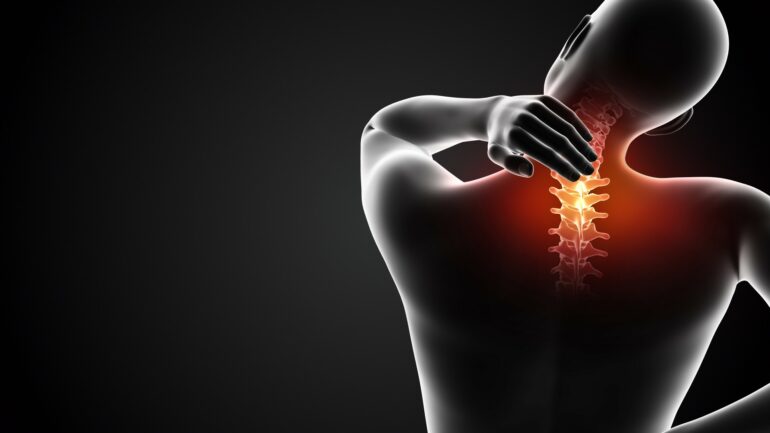The mental distress of cognitive dissonance—encountering information that conflicts with how we act or what we believe—can lead to added pressure on the neck and low back during lifting and lowering tasks, new research suggests.
When study participants were told they were performing poorly in a precision lowering experiment in the lab, after initially being told they were doing well, their movements were linked to increased loads on vertebrae in their neck and low back.
Results showed that the higher the cognitive dissonance score, the greater the extent of loading on the upper and lower parts of the spine.
The finding suggests cognitive dissonance may be a previously unidentified risk factor for neck and low back pain, which could have implications for risk prevention in the workplace, according to researchers.
“This increased spine loading occurred under just one condition with a fairly light load—you can imagine what this would be like with more complex tasks or higher loads,” said senior author William Marras, executive director of the Spine Research Institute at The Ohio State University. “Basically, the study scratched the surface of showing there’s something to this.”
The research was published recently in the journal Ergonomics.
Marras’ lab has been studying daily living and occupational forces on the spine for decades. About 20 years ago, he found that psychological stress could influence spine biomechanics, using a study design that involved having a fake argument with a graduate student in front of research participants.
“We found that in certain personality types, the loads in the spine increased by up to 35%,” Marras said. “We ended up finding that when you’re under that kind of psychosocial stress, what you tend to do is what we call co-activate muscles in your torso. It creates this tug of war in the muscles because you’re always tense.
“In this study, to get at that mind-body connection, we decided to look at the way people think and, with cognitive dissonance, when people are disturbed by their thoughts.”
Seventeen research participants—nine men and eight women aged 19-44—completed three phases of an experiment in which they placed a light-weight box within a square on a surface that was moved left and right, up and down. After a short practice run, researchers gave almost exclusively positive feedback during the first of two 45-minute trial blocks. During the second, the feedback increasingly suggested participants were performing in an unsatisfactory way.
To arrive at a cognitive dissonance score for each participant, changes during the experiment to blood pressure and heart rate variability were combined with responses to two questionnaires assessing discomfort levels as well as positive and negative affect—feeling strong and inspired versus distressed and ashamed.
Wearable sensors and motion-capture technology were used to detect peak spinal loads in the neck and low back: both compression of vertebrae and vertebral movement, or shear, from side to side (lateral) and forward and back (A/P).
Statistical modeling showed that, on average, peak spinal loads on cervical vertebrae in the neck were 11.1% higher in compression, 9.4% higher in A/P shear and 19.3% higher in lateral shear during the negative-feedback trial block compared to the baseline measures from the practice run. Peak loading in the lumbar region of the low back—an area that bears the brunt of any spinal loading—increased by 1.7% in compression and 2.2% in shear during the final trial block.
“Part of the motivation here was to see whether cognitive dissonance can manifest itself not only in the low back—we thought we’d find it there, but we didn’t know what we’d find in the neck. We did find a pretty strong response in the neck,” said Marras, a professor of integrated systems engineering with College of Medicine academic appointments in neurosurgery, orthopaedics and physical medicine and rehabilitation.
“Our tolerance to shear is much, much lower than it is to compression, so that’s why that’s important,” he said. “A small percentage of load is no big deal for one time. But think about when you’re working day in and day out, and you’re in a job where you’re doing this 40 hours a week—that could be significant, and be the difference between a disorder and not having a disorder.”
Marras is also principal investigator on a federally funded multi-institution clinical trial assessing different treatments for low back pain that range from medication to exercise to cognitive behavioral therapy.
“We’re trying to unravel this onion and understand all the different things that affect spine disorders because it’s really, really complex,” he said. “Just like the whole system has got to be right for a car to run correctly, we’re learning that that’s the way it is with the spine. You could be in physically great shape, but if you’re not thinking correctly or appropriately, or you have all these mental irregularities, like cognitive dissonance, that will affect the system. And until you get that right, you’re not going to be right.
“We’re looking for causal pathways. And now we can say cognitive dissonance plays a role and here’s how it works.”
More information:
Eric B. Weston et al, Cognitive dissonance increases spine loading in the neck and low back, Ergonomics (2023). DOI: 10.1080/00140139.2023.2186323
Provided by
The Ohio State University
Citation:
Your thoughts can harm your neck and back during lifting tasks (2023, May 25)
